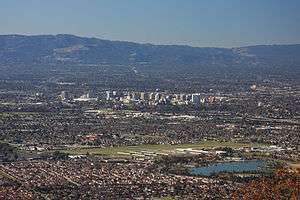King and Story
 | |
| Maintained by | Local jurisdictions |
|---|---|
| West end | McLaughlin Avenue & Story Road |
| Major junctions |
|
| East end | Jackson Avenue & Story Road |
The intersection of King and Story serves as an important marker for a neighborhood in East San Jose, California.
The area surrounding King and Story, zip code 95122, is a hub for the East San Jose Community and for Latino culture in San Jose.[1] The neighborhood is sometimes known as Tropicana, after the shopping center on the southwest corner of the intersection. In the 1930s, future agricultural labor union leader César Chávez and his family moved into the neighborhood. It was here that Chávez first began his political actions, registering voters and organizing English language classes for the mostly Mexican American residents. The first grocery stores targeted by the NFWA grape boycott were on King Road. In the 1980s the area was a hub of lowrider culture, and the Mural de la Raza, which depicts Chicano history and was created on a wall near the intersection in that decade, is now one of the oldest murals in the city.[2] The Mi Pueblo Hispanic supermarket chain started at the intersection.[3]
At the start of the 21st century, the San Jose Redevelopment Agency pursued redevelopment of the intersection, successfully locating a grocery store on the north-east corner before pursuing eminent domain to redevelop the southeast and southwest corners. On the southeast corner, in conjunction with local developers Blake-Hunt Ventures, vacant and abandoned buildings were replaced with needed banking and shopping options. However, after encountering a court challenge to its acquisition of the Tropicana shopping center on the southwest corner, the city paid $6.8 million in 2002 to the primary landowner who contended that his own redevelopment plans had been unfairly interfered with,[4] and settled for acquisition of certain portions and the redevelopment of the remainder in conjunction with the existing owners.
In 2003, the San Jose City Council considered a bill to rename King Road, named for an 1851 settler to San Jose, after Martin Luther King, Jr. The proposal was generally supported by the African American community and opposed by the Hispanic population. The city council eventually rejected the proposal.[5]
In the late 2000s the neighborhood was badly impacted by the subprime mortgage crisis.[6]
King Road is home to a One Stop county services building, and near Eastridge Shopping Mall, which has been expanded. BART (Bay Area Rapid Transit) and Valley Transportation Authority (VTA) light rail are expanding into the region. Redevelopment of some neighborhoods is also a city priority.
Lowriding
King and Story is also recognized as being the Whittier Boulevard of the north which has many similar characteristics as East Los Angeles. The usage and showings of lowriders is prevalent along King Rd and Story Rd.
Lowriders didn’t start in San Jose. Lowering a car’s chassis below the rims and giving it a sweet paint job — going “low and slow” as you cruised the main drag — started in Los Angeles in the 1940s. But by the 1960s, the culture had developed heavily in San Jose, where cruising along the wide avenues of Story Road and Alum Rock Avenue became weekend night rituals for a Mexican-American community that was growing — and growing restless. Lowrider magazine was founded in San Jose in 1977 by San Jose State students Larry Gonzalez, Sonny Madrid, and David Nunez. It celebrated not only the cars, but the culture that spawned them. (Of course, it may be best remembered by some for the scantily clad women featured in its pages). Today, lowrider culture permeates mainstream society through art, music and, most especially, cars. Several South Bay car clubs still bring out their best for Show n Shine events and it wouldn’t be Cinco de Mayo in San Jose without seeing lowriders cruising down Alum Rock Avenue toward downtown.[7]
References
- ↑ Kelsey E. Thomas, "San Jose Embraced Six Miles of Open Streets", Next City, February 19, 2016: "We chose the route because it goes through San Jose's most diverse neighborhoods ... Story and King is the commercial heart of San Jose's Latino community".
- ↑ Troy Wolverton, "San Jose bike riders get tour of city, murals and culture", San Jose Mercury News, March 4, 2017, updated March 10, 2017.
- ↑ Matt O'Brien, "Mi Pueblo markets came under U.S. immigration audit, company says", San Jose Mercury News, October 5, 2012, updated August 12, 2016.
- ↑ Ramona Giwargis, "San Jose: New development at Tropicana angers business owners", San Jose Mercury News, September 5, 2016, updated September 7, 2016.
- ↑ Owen J. Dwyer and Derek H. Alderman, Civil Rights Memorials and the Geography of Memory, Center Books on the American South 11, Chicago: Center for American Places at Columbia College Chicago, 2008, ISBN 9781930066717, p. 87, p. 121 n. 42.
- ↑ "A neighborhood shattered: Tropicana is epicenter of San Jose’s foreclosure crisis", San Jose Mercury News, March 19, 2009.
- ↑ "46. Lowrider Culture". www.great408.org. Retrieved 2018-04-30.